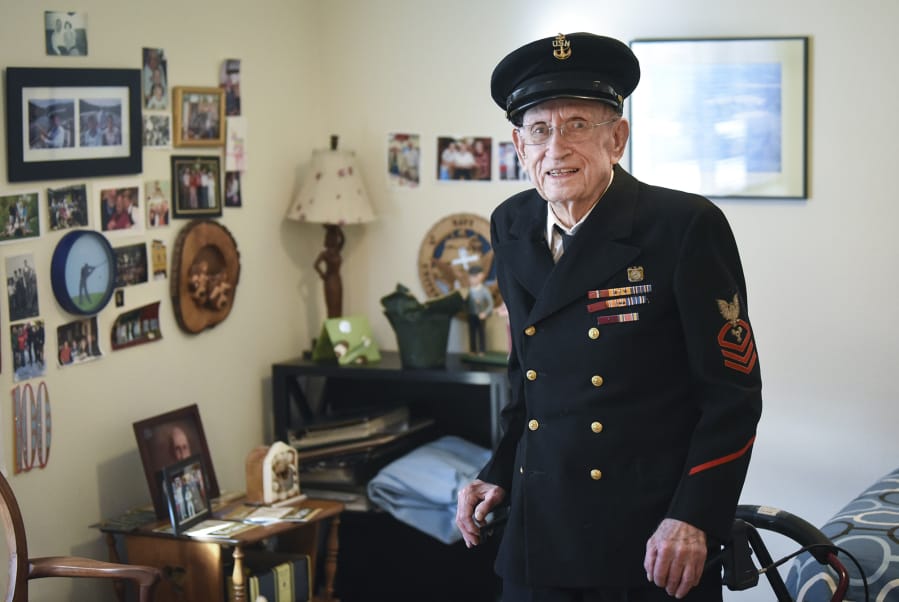At 100 years old, Jim Christian is still proud to put on his brass-buttoned Navy uniform for a Veterans Day honor guard, as he did two months ago.
Christian represents World War II veterans through more than his 75-year-old uniform, however. He logged 44 months of sea-going service, in places where history happened. His stories reflect what millions of Americans experienced from 1941 to 1945.
His memories of climactic campaigns remain vivid; he can recall his ship’s role in the battle for Guadalcanal in detail.
But Christian also wrote a memoir for his family. While it includes extended accounts of the war in the Pacific, there are personal insights.
Longing for a loved one.
Moving aside a shipmate who is paralyzed by fear.
Manning a machine gun while watching the flashes from Japanese ships that are firing 10-inch shells.
Christian spent WWII on the USS Fomalhaut, a cargo ship. As a motor machinist, Christian tended the engine that powered the 412-foot-long ship, as well as two diesel generators.
He had another assignment during general quarters, which could include an imminent battle, submarine sighting or other emergency. He manned a .50-caliber machine gun above the bridge.
The Fomalhaut also had two roles during the war. Its first assignment was highlighted by the battle for Guadalcanal, an island where Japanese forces were building an air base. It was the Allies’ first major offensive in the Pacific, and Christian’s ship was part of the initial invasion.
“We transported Marines and their gear. They went over the side, down nets, and into eight landing craft,” he said.
The battle stretched into a six-month campaign. The Japanese counter-attacked by air and sea. A couple of nights after the initial attack, several of the transports were anchored in a channel just off the island when Navy warships met a Japanese squadron.
Christian wrote that it “was close enough to see the gun flashes. We knew that if the Japanese ships got past our fighting ships, we would be sitting ducks … I thought of my .50 caliber machine gun against their 8- and 10-inch guns.”
The Japanese ships finally withdrew.
Christian’s ship was hit by machine-gun fire during one sweep by enemy fighter planes. But by the time he got to his machine gun, the shooting was over, Christian wrote.
As several men were heading for their duty stations, a sailor “just froze on the ladder,” Christian wrote. “It took two or three of us to clear him out of the way so we could continue to our posts.”
Nobody ever did talk about the guy, he noted. “No one ever knows for sure what he might do under pressure.”
Christian’s first wife, Verna, comes up frequently in his memoirs. They married six days after the Dec. 7, 1941, attack on Pearl Harbor. (She later died of breast cancer.)
While Christian was at sea, his wife was living in the Portland-Vancouver area. She worked as a secretary for Edgar Kaiser, who managed the Kaiser shipyards in Vancouver and Portland.
One of Christian’s friends illustrated how the war could affect relationships. The sailor asked a shipmate who was going back to the mainland to say hi to his girlfriend in California. Three months later, Christian’s buddy got a “Dear John” letter from his girlfriend; she was marrying the other sailor.
“I praise Verna for being so true and waiting for me,” Christian wrote.
After 28 months of supply runs, the USS Fomalhaut was sent to Norfolk, Va., to be converted to an ammunition ship.
Christian and his shipmates then spent 16 months more in the Pacific. They provided firepower for Navy warships in campaigns that included the Philippines, and then Okinawa.
While Christian was in the Philippines, he came across something that still is a factor in his life: a beautiful piece of wood.
When he and a friend looked at the ruins of a school, Christian saw that it had been built of mahogany. They decided to make chess pieces in the ship’s shop and bargained with a local man for pieces of ebony and mahogany.
A couple of days later, the man showed up with two 5-foot-long logs. The two sailors skipped movie showings and made two sets of chess pieces.
And Christian is still a woodworker. In his apartment at VanMall Retirement Center, he recently showed off some of the wooden tops he makes for kids in his family.
It’s something that’s helped him top the century mark, he said.
“Keep busy. Having a good hobby helps.”




